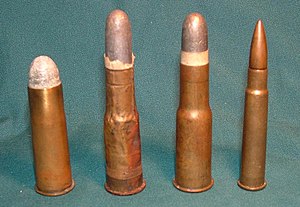| .577/450 Martini–Henry | ||||||||||||
|---|---|---|---|---|---|---|---|---|---|---|---|---|
 (From left to right): A .577 Snider cartridge, a Zulu War-era rolled-brass-foil .577/450 Martini–Henry cartridge, a later drawn-brass .577/450 Martini–Henry cartridge, and a .303 British Mk VII SAA ball cartridge. | ||||||||||||
| Type | Military | |||||||||||
| Place of origin |
| |||||||||||
| Service history | ||||||||||||
| Used by | British Empire | |||||||||||
| Wars | Anglo-Zulu War | |||||||||||
| Production history | ||||||||||||
| Designed | 1871 | |||||||||||
| Variants | 11.43×60R (61R) | |||||||||||
| Specifications | ||||||||||||
| Parent cartridge | .577 Snider | |||||||||||
| Bullet diameter | .455 in (11.6 mm) | |||||||||||
| Neck diameter | .487 in (12.4 mm) | |||||||||||
| Shoulder diameter | .628 in (16.0 mm) | |||||||||||
| Base diameter | .668 in (17.0 mm) | |||||||||||
| Rim diameter | .746 in (18.9 mm) | |||||||||||
| Rim thickness | .06 in (1.5 mm) | |||||||||||
| Case length | 2.34 in (59 mm) | |||||||||||
| Overall length | 3.12 in (79 mm) | |||||||||||
Ballistic performance
| ||||||||||||
|
Source(s): Handbook for Shooters & Reloaders[1] Handloaders Manual of Cartridge Conversion[2] | ||||||||||||
The .577/450 Martini–Henry was a black powder, centrefire round used by the British and British Empire militaries prior to the adoption of the .303 calibre cartridge used in the Lee–Metford, Martini–Enfield, and Lee–Enfield series of rifles alongside the Nepalese Bira gun.[1] This cartridge is also sometimes known as 11.43×60R (61R).[2]
Background[]
The .577/450 was based upon the same separate steel head used for the .577 Snider cartridge, with a wrapped foil body firing a nominally .45 calibre bullet, giving the cartridge a "bottle-necked" appearance. Initially, .577/450 cartridges were manufactured of rolled brass foil with an iron rim, but later on—shortly after the Anglo-Zulu War—it was discovered that the rolled foil cartridges were prone to jamming as the barrel heated up, and production was switched to the drawn brass style now commonly used for the manufacture of small arms ammunition.
The Martini–Henry single-shot lever-action rifle had a Martini-designed action married to the unique rifling designed by Alexander Henry. The first three patterns or "marks" were equipped with a shorter lever, which was extended in the Mark IV pattern to address extraction problems in some climates. The Mark IV was the final and most refined form of the rifle in .577/450, but was already obsolete owing to the pending adoption of a smokeless powder small bore cartridge, which became the .303.
Uses[]
The cartridge was most famously employed by British forces during the Anglo-Zulu War of 1879—which included the Battle of Isandlwana and the Battle of Rorke's Drift—as well as during the Sudanese Campaign of 1884–1898, and in various other colonial conflicts in Africa and India. By the end of the 19th century, the .577/450 Martini–Henry cartridge was considered obsolete, though it was still in military production as late as World War I (for use by Royal Flying Corps observers and Zeppelin-buster aircrews, using an incendiary spitzer bullet), and in commercial production by Kynoch until the late 1950s.
The load used by the military was 85 grains (5.5 g) of black powder with a 480-grain (31 g) bullet at 1,350 ft/s (410 m/s).[1]
Due primarily to the fact that it was used so extensively by the British Army, the .577/450 Martini–Henry was also very popular among hunters all over the world for many years. It has been used to hunt virtually every possible species of big game including deer, plains game, tiger, and even elephant.[3] The cartridge has fallen out of use in recent years because of the difficulty involved in obtaining ammunition. However, the .577/450 Martini–Henry is still used occasionally by hunters, especially in the former British colonies, and is a great choice for hunting medium and large game.
See also[]
- .577 Nitro Express
- .577 Snider
- List of rifle cartridges
- Table of handgun and rifle cartridges
- 11 mm caliber
References[]
- Cartridges of the World 4th Edition, by Frank C. Barnes, DBI Books, p. 214.
- ↑ 1.0 1.1 1.2 Ackley, P.O. (1979) [1966]. Handbook for Shooters & Reloaders. vol II (8th Printing ed.). Salt Lake City, Utah: Plaza Publishing. p. 215. ASIN B000BGII48.
- ↑ 2.0 2.1 Donnelly, John J. (1987). The Handloader's Manual of Cartridge Conversions. Stoeger Publishing. p. 687. ISBN 978-0-88317-269-8.
- ↑ ".577/450 Martini–Henry: The Right Arm Of The British Empire". The Big Game Hunting Blog. http://thebiggamehuntingblog.com/2015/06/the-577450-martini-henry-the-right-arm-of-the-british-empire/.
External links[]
- Martini Henry—information on the Martini–Henry and Martini–Enfield rifles, and cartridges thereof.
- .577/.450 Martini–Henry Rifles
The original article can be found at .577/450 Martini–Henry and the edit history here.